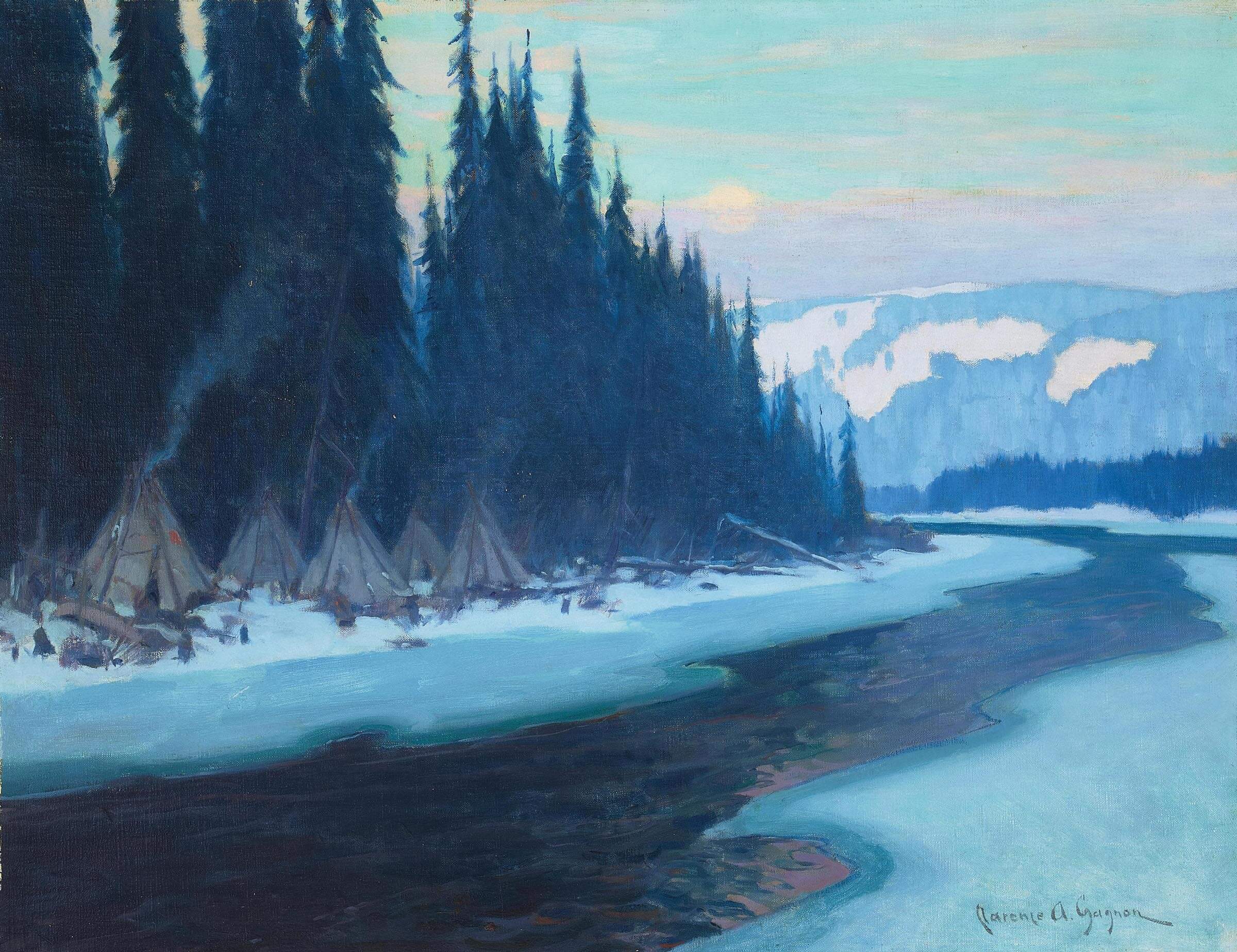
04 Jul Auction Block: From Historic Treasures to Contemporary Triumphs
This spring, art auctions and events showcased the diverse talents of artists past and present, and collectors showed support for their creative efforts.
Bonhams presented an exciting slate of auctions in Los Angeles, New York, and online dedicated to historically significant works. Their American Art auction brought more than $3.9 million, with a work by Marsden Hartley leading the sale at $1.1 million. Also notable was the more than $2.5 million result from Bonhams’ California & Western Art auction, highlighted by a painting from one of the most influential California Impressionists, Guy Rose. And during the auction house’s Modern Native American Art and Jewelry sale, a work from Luiseño painter Fritz Scholder far exceeded its high estimate of $50,000 to bring $330,700.
The National Cowboy & Western Heritage Museum held its 52nd Prix de West Invitational Art Exhibition & Sale in June, and artist George Carlson was honored with the prestigious Prix de West Lifetime Achievement Award. Carlson, who has participated in Prix de West for 40 years, is only the fifth artist to earn such recognition.
National Cowboy & Western Heritage Museum: Prix de West Invitational Art Exhibition
June 7 – 8
Total: $3 million+
The National Cowboy & Western Heritage Museum held its 52nd Prix de West Invitational Art Exhibition & Sale on June 7 and 8. The event is the museum’s largest annual fundraiser, featuring a live auction and a fixed-price art sale to support exhibitions and family programming. The 2024 event generated more than $3 million in sales.
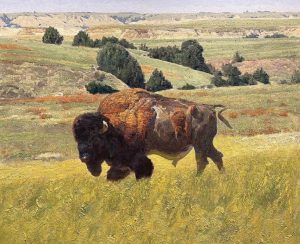
George Carlson, American Bison | Oil on Linen | 34 x 40 inches | Price: $70,000
This year’s Prix de West showcased nearly 300 Western paintings and sculptures by the nation’s finest contemporary Western artists. The works ranged from historical pieces that reflect the early days of the West to more contemporary and impressionist ones. The Art Sale Weekend on June 7 and 8 included the auction and fixed-price sale, as well as art seminars, workshops, cocktail receptions, and an awards dinner recognizing outstanding artistic merit on June 8.
George Carlson, a 40-year Prix de West exhibiting artist, was honored with the prestigious Prix de West Lifetime Achievement Award. This award, which Carlson is the fifth recipient of in the event’s history, recognizes an artist’s significant and enduring contribution to the Western art community. To be considered for the Prix de West Lifetime Achievement Award, an artist’s body of work must span decades, reflect creativity and sensitivity in subject matter, and exhibit continuous innovation and excellence in execution.
Carlson was also honored with the Robert Lougheed Memorial Award and $3,000 for best display of three or more works for his paintings Northern Tapestry (sold: $85,000), American Bison (priced at $70,000 and available for purchase), After the Burn (priced: $68,000), and Eagle Creek (sold: $58,000). The award was chosen by Prix de West exhibiting artists.
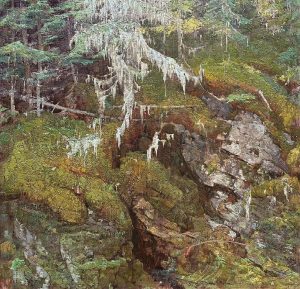
George Carlson, Northern Tapestry | Oil on Linen | 42 x 42 inches | Sold: $85,000
The top-honored Prix de West Purchase Award was presented to Thomas Blackshear II for his oil painting A Much Needed Break. Blackshear received the $45,000 purchase price, a $5,000 award, and the Prix de West medallion, sponsored by Roberta M. Eldridge Miller. The artist is known for his vivid Western paintings depicting the strength within Black and Native American cultures, which he calls “Western nouveau.”
Dean Mitchell received the Directors’ Choice Award for Excellence for his acrylic painting Why, which addresses the 1921 Tulsa Race Massacre. Sponsored by the Prix de West committee, Mitchell was awarded $3,000 and a commemorative gold bolo. The painting sold for $20,000.
Additional awards were presented to: Daniel Smith, Buyers’ Choice Award for Winter’s Shroud (sold: $21,000); T. Allen Lawson, Frederic Remington Painting Award for Seeking Shelter (sold: $90,000); Kyle Sims, Major General and Mrs. Don D. Pittman Wildlife Award for Survival of the Fittest (priced: $38,000); Dan Friday, James Earle Fraser Sculpture Award for Lummi Blanket Basket (sold: $7,000); Abigail Gutting, Express Ranches Great American Cowboy Award for Runnin’ on Empty (sold: $13,500); Joel R. Johnson, Donald Teague Memorial Award for Mesa Reflections (sold: $12,000); and Grant Redden, Wilson Hurley Award for Outstanding Landscape for November Snow (sold: $35,000).
All unsold art remains on exhibit and available for purchase through August 4.
Phippen Museum: 50th Annual Western Art Show and Sale
May 26 – 27
Total: N/A
On Memorial Day, the Phippen Museum presented the 50th annual Western Art Show and Sale. Nearly 100 artists from across the U.S. participated, drawing locals, visitors, art collectors, tourists, and Western enthusiasts to the Yavapai County Courthouse Plaza in downtown Prescott, Arizona. Patrons purchased works directly from the artists by visiting their booths, taking advantage of the opportunity to talk about the work and meet the creators.

Dane Chinnock, Tilting at Windmills | Oil with Palette Knife on Linen | 10 x 40 inches | Best of Show
In addition to the artists’ booths on the Courthouse Plaza, the museum also presented the annual Miniature Masterpiece Show & Sale, featuring more than 60 drawings, paintings, and sculptures. These miniature masterpieces were on display at the museum throughout May and the exhibition culminated with an exciting sale-by-draw on Memorial Day, May 27. Additional festivities included the first Hometown Hoedown, the 66 Kids Roadshow at the Elks Theatre, two quick-draws with live art auctions, and an artist awards ceremony.
This year’s Best of Show winner was Dane Chinnock, who also won first place in oil for his piece Tilting at Windmills. Chinnock grew up in Tucson and Prescott, Arizona, where, as a child, he recalls the scent of his mother’s oil paints. “To express the beauty of creation through painting and, in turn, have someone moved emotionally by my painting is my reward,” says Chinnock, who resides in Georgetown, Texas.
Selected artists were awarded first through third places in seven mediums: drawing, mixed media, oil, pastel, acrylic, sculpture, and watercolor. Other artists were recognized with several special awards, including artist Lee Rue, who won the George Phippen Memorial Foundation Award; Tamara Magdalina, who won the Phippen Family Award; Sonja Jones, who won the Southwest Art Award of Excellence; John Morey, who won the Art of the West Award of Excellence; James Loveless Jr., who won the Western Art Collector Award of Excellence; Bill Cramer, who won the Montgomery Frames Award; and Carl Wolf, who won the 2024 Peoples’ Choice Award.
Bonhams’ California & Western Art
April 23
Total: $2.5 million+
On April 23 in Los Angeles, Bonhams’ California and Western Art sale offered a selection of paintings, works on paper, and sculptures that captured the splendor and diversity of the American West. The 133 lots brought more than $2.5 million in sales.
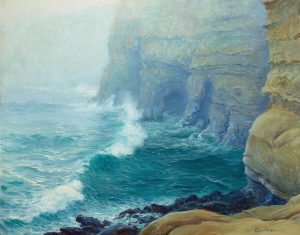
Guy Rose, Lifting Fog, La Jolla Cliffs | Oil on Canvas | 32 x 39.25 inches | Sold: $508,000
The auction was highlighted by a painting from California Impressionist Guy Rose [1867–1925]. Lifting Fog, La Jolla Cliffs was the top-selling item, bringing more than $508,000 amid estimates of $400,000 to $600,000. According to Bonhams, in addition to being one of California’s few native-born plein-air painters, Rose is perhaps best known for his time spent in the French art colony of Giverny and his associations with Claude Monet. It wasn’t until Rose reached maturity in his career, however, that he could fully apply the tenets of French Impressionism to a more familiar setting — his home state. Lifting Fog, La Jolla Cliffs was painted when this confluence of French style and California subject reached an apogee. Devoid of any figures or vegetation, Lifting Fog is one of Rose’s most introspective looks at the California coastline. Color, therefore, serves a dual purpose, with the cool palette not only denoting the weather but also adding to the overall atmospheric sentiment.
A work by one of the early 20th century’s premiere portraitists of the Southwest, Nicolai Fechin [1881–1955] was the second top-selling item. Monterey Bay Seascape sold for $191,000 amid estimates of $150,000 to $250,000. Best known for his time spent in Taos, New Mexico, Fechin’s Russian training and unusual use of a palette knife made his work distinctive from other artists practicing in the region at the time.
The third top-selling item was a work by Joseph Kleitsch [1882–1931], an important early California Impressionist painter. My Garden (The Artist’s Home, Laguna Beach) sold for $152,900, above its high estimate of $100,000. Kleitsch arrived in the U.S. from Hungary in 1902 and began painting “the strong and clear light of Laguna Beach” in 1920 after earning a reputation for his still-life paintings and portraits, according to the Laguna Art Museum.
Laguna was also the subject of William Wendt’s [1865–1946] painting, which was the fourth top-selling item. Laguna Hills sold for $121,150, just above its high estimate of $120,000. William Wendt was born in Bentzen, Germany, in 1865 and immigrated to Chicago in 1880. He briefly attended the Art Institute of Chicago but remained largely self-taught as a painter. His deep reverence for nature is well-documented in his work, primarily focusing on plein-air landscape painting. In 1911, Wendt co-founded the California Art Club and served as its president during various terms. He was elected an Associate of the National Academy of Design in 1912 and built his home and studio in Laguna Beach, where he lived for the rest of his life. Wendt earned the title “dean of Southern California artists” for his significant contributions to the art community and his distinctive style, which focused on rich, bold colors and natural compositions.
The fifth top-selling work was Winter Camp Along a River, Quebec by Canadian artist Clarence Alphonse Gagnon, which sold for $114,800 amid estimates of $100,000 to $150,000. Clarence Alphonse Gagnon was a painter and printmaker whose work, despite the artist’s extensive time in France, focused primarily on the picturesque Canadian winter landscape of the Charlevoix region of Quebec. Gagnon was born in Montreal and began his artistic studies at the Art Association of Montreal under William Brymner at age 16. In 1904, Gagnon went to Paris for a year of study at the Académie Julian. In Winter Camp Along a River, Gagnon presents an unusual motif of an Indigenous winter encampment nestled beneath tall pine trees along the shore of a sinuous icy stream. As the stream flows in the background and hazy Laurentian Mountains are in view. While there are no figures in the scene, smoke snakes out of the tops of the tipis, and an overturned canoe is visible.
Bonhams also offered an online sale of California and Western Art from April 16 through 26. The sale brought more than $350,000 for the 238 lots offered. Noted works include The Minarets (Ritter Range, Sierra Nevada Mountains) by William Lees Judson [1842–1928] (sold: $10,240, high estimate: $6,000); Farallon Islands by Ludmilla Pilat Welch [1867–1925] (sold: $8,960, high estimate: $5,000); and Sierra Pool by Gregory Hull (born 1950) (sold: $8,960, high estimate: $2,400).
Bonhams’ Modern Native American Art and Jewelry
April 30
Total: $1.4 million+
On April 30 in Los Angeles, Bonhams’ Modern Native American Art and Jewelry sale featured an impressive selection of works by established and up-and-coming Indigenous artists, such as Fritz Scholder, Oscar Howe, Jaune Quick-To-See Smith, Charles Loloma, Rose Simpson, Rhonda Holy Bear, John Nieto, and Jesse Monongya. The auction of 173 lots brought more than $1.4 million.
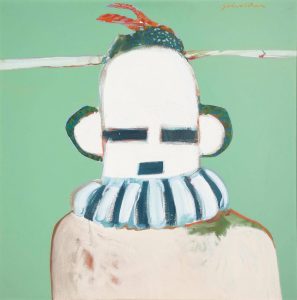
Fritz Scholder, Indian with Mask | Oil on Canvas | 30 x 30 inches | Sold: $330,700
Several works from Luiseño painter and colorist Fritz Scholder [1937–2005] highlighted the sale. The top-selling lot was Indian with Mask (1968), which brought $330,700, exceeding its high estimate of $50,000. Often associated with a Pop aesthetic, Scholder used bright colors and modern-day cultural objects juxtaposed against traditional Indigenous symbols, masks, and patterns to expose the dueling forces of contemporary Native American life. Indian with Mask depicts in oil a portrait of a masked individual against a flat sage-green background. The eyes and mouth are represented by dark rectangular slits, leading to more sustained attention to the features of the mask: the feathered headdress, the protruding ears, and the elaborate collar. The inability of the viewer to access the person behind the mask and assess their true sense of identity makes this a psychologically charged representation, according to Bonhams.
Scholder’s Dartmouth Portrait #3 (1973) was the second top-selling item, achieving more than $254,000, above its high estimate of $150,000. Painted while Scholder was an artist-in-residence at Dartmouth College, the oil of an Indigenous man against a bold red background was one in a series that brought Scholder to the attention of the wider art world.
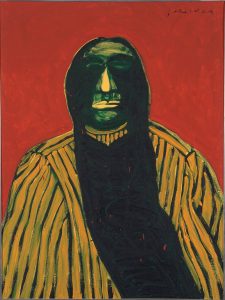
Fritz Scholder, Dartmouth Portrait #3 | Oil on Canvas | 40 x 30 inches | Sold: $254,000
The sale also presented a fresh-to-market painting, Sioux Bear Dancer (c. 1954), by Oscar Howe (Yanktonai Dakota, 1915–1983), which sold for $222,750, above its high estimate of $120,000, to earn third position during the auction. An incredibly influential figure in contemporary Native American art, the work by Howe was estimated to bring $80,000 to $120,000. Howe was known for challenging the art establishment’s preconceptions and definitions of Native American painting with work that was simultaneously modern and embedded in traditional Dakota culture and aesthetics.
The fourth top-selling lot was an untitled pastel drawing from another groundbreaking artist, Jaune Quick-to-See Smith (b. 1940). The striking abstract work in warm earth tones is from the artist’s Kalispell Series. The pastel sold for $44,800, above its high estimate of $44,000.
The fifth top-selling item was a painting by Rose B. Simpson (Santa Clara Pueblo), titled Cold Hard Truth (2006). The painting employs text, bold color, and portraiture to convey its meaning. The work sold for $42,240, far exceeding its high estimate of $2,000.
Additional highlights from the auction include a mosaic cuff bracelet by Charles Loloma [1921–1991], a highly influential Hopi jeweler and artist. The bracelet was made circa 1985 and sold amid estimates of $20,000 to $40,000 for more than $28,000. Loloma is known for popularizing the use of gold and gemstones in Hopi jewelry. And a Pueblo-style gold and coral necklace with gold dragonfly crosses interspersed by Jesse Monongya (b. 1952) sold for more than $16,000, amid estimates of $12,000 to $18,000. A master Navajo/Hopi jewelry designer, Monongya is best known for the night sky designs he places within a bear shape and other forms, as well as the inspiration he takes from dramatic southwestern landscapes.
Bonhams’ American Art
May 1
Sale total: $3.9 million+
On May 1, Bonhams’ American Art sale in New York brought more than $3.9 million for the 93 lots offered at auction. The top-selling item was a work by the American Modernist painter and poet Marsden Hartley [1877–1943], New Mexico Recollection No. 8. While working in Germany in 1923, Hartley completed a rush of expressive landscape paintings from memory that have since become collectively known as the New Mexico Recollection series. As one of the 20 works from that significant series, No. 8 is a foreboding and complex, multilayered manifestation of Hartley’s state of mind post-World War I, according to Bonhams. The painting was estimated to sell for $400,000 to $600,000 and instead brought more than $1.1 million.
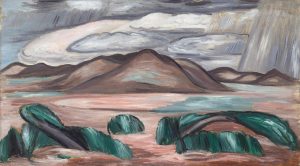
Marsden Hartley, New Mexico Recollection #8 | Oil on Canvas | 23.375 x 41.5 inches | Sold: $1.1 million
The second top-selling item was Andrew Wyeth’s [1917–2009] Knapsack. The refined study was produced in 1978 by the artist for his finished painting by the same title, a pivotal work in developing his famed Helga Pictures, a series depicting his favored model, Helga Testorf. Though Wyeth purposefully infuses a passionate affection for Helga into each image of her, he maintained that depicting her charged beauty was not his primary intent. “The heart of the Helga series is that I was trying to unlock my emotions in capturing her essence, in getting her humanity down,” says Wyeth. The oil sold amid estimates of $250,000 to $350,000 for $318,000.
A work by Wolf Kahn [1927–2020], Pink Light on the Sea, was the third top lot. The work, which debuts the alluring color that Kahn was known for, will be included in the Wolf Kahn Foundation’s catalogue raisonné of the artist’s work. The vibrant painting sold for $298,950, above the high estimate of $120,000.
The fourth top-selling item was North Broadway Neighborhood by Paul Sample [1896–1974]. The oil on canvas depicts a neighborhood scene with a streetcar traveling between rows of houses in the foreground. Beyond is a busy railroad yard lined with warehouses and waiting freight trains, smoke pouring from their smokestacks. Visible in the distance is the New York City skyline. The painting sold for $241,800, exceeding its high estimate of $30,000.
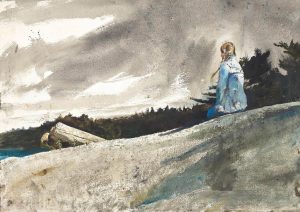
Andrew Wyeth, Knapsack | Watercolor and Pencil on Paper | 21.375 x 29.875 inches | Sold: $318,000
A work by Thomas Moran [1837–1926], Santa Maria della Salute, Venice (1915), rounded out the top five sellers. Sublime and romantic, Santa Maria della Salute, Venice was painted in 1915, nearly three decades after the artist first visited Venice, Italy, according to Bonhams. The work of Romantic painters and writers, including J.M.W. Turner [1775–1851], John Ruskin [1819–1900], and Lord Byron [1788–1824], initially introduced Moran to the city. When he witnessed the city’s splendor firsthand in May 1886, it was a thrilling and profound experience. Moran wrote to his wife Mary, “Venice is all, and more, than travelers have reported of it. It is wonderful. I shall make no attempt at description…” Moran returned to Venice on a second sketching trip in 1890, and he used the extensive plein air drawing and watercolor studies he produced on both of his visits as the basis for larger and more finished oil paintings he created in his studio, such as Santa Maria della Salute, Venice. The painting, which presents a sensory view of the architectural splendor of the city while also exploring light, color, and imagery influenced by the Romantics, sold amid estimates of $150,000 to $250,000 for more than $171,000.
Additional highlights from Bonhams’ American Art auction include a William Bradford painting, Fresh Breeze off Sandy Hook, which brought $146,550 (estimate: $60,000 – $80,000); an Anna Mary Robertson “Grandma” Moses’ painting, The Old Oaken Bucket, which sold for $127,500 (estimate: $80,000 – $120,000; and another work by Hartley, a still-life painting from 1926–28 titled Green and Purple Grapes in a Basket, which sold for more than $121,000 (estimate: $100,000 – $150,000).
Bonhams’ Native American Art
June 13
Total: $560,000+
On June 13 in Los Angeles, Bonhams auctioned 331 works by Native American artists, achieving more than $560,000 in sales.
The top-selling item was a fine and early Diné (Navajo) first-phase concha belt, which sold for $28,160, above the high estimate of $6,000. The unknown artist who created the belt used a thin leather piece to string together seven large domed oval conches with pierced and stamped scalloped borders. This adornment was achieved with limited tools, according to Bonhams.
The second highest-achieving sum went to a room-sized Sunrise Klagetoh rug, which sold for $16,640 amid estimates of $15,000 to $20,000. The approximately 22-by-10-foot rug was woven with an elongated concentric diamond medallion flanked by floating geometric elements.
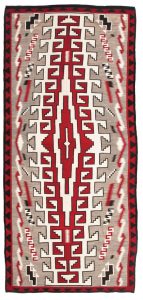
Sunrise Klagetoh Rug | 122 x 259 inches | Sold: $16,640
A Hopi katsina figure depicting Shalako Mana exceeded its high estimate of $8,000 and sold for $14,080 to become the third top-selling lot. The 12-inch-high figure is made of carved cottonwood painted with mineral pigments. According to Bonhams, in a photograph taken circa 1920, Elizabeth De Huff is pictured with a selection of figures, including this one held in her hand. An artist, educator, and author, De Huff is perhaps best known as one of the primary contributors to the development of Native American easel painting in Santa Fe in the first quarter of the 20th century. As a result of the Bureau of Indian Affairs prohibiting arts training at the Santa Fe Indian School (where her husband John D. De Huff was for a time superintendent), De Huff taught painting to students out of her home. Among her first students were Hopi artists Fred Kabotie and Otis Polelonema, Velino Shije Herrera of Zuni, and Awa Tsireh of San Ildefonso Pueblo. In the book Fred Kabotie, Hopi Indian artist: An autobiography told with Bill Belknap, Kabotie recounts, “That was how my painting began, in the school year of 1916-17. Mrs. De Huff got me some drawing paper and watercolors, and I started painting things I remembered from home, mostly kachinas. When you’re so remote from your own people you get lonesome. You don’t paint what’s around you, you paint what you have in mind. Loneliness moves you to express something of your home, your background. The first time Mrs. De Huff saw my kachinas, she asked, ‘What are these?’ She didn’t know anything about them.”
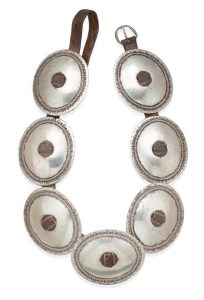
Diné (Navajo) First-Phase Concha Belt | Silver and Leather | 41 inches long | Sold: $28,160
A Diné (Navajo) squash blossom necklace sold above its high estimate of $3,500 for $14,080, as the fourth top-selling lot. The 27-inch-long necklace is composed of a single strand of silver beads interspersed with eight stamped tripartite blossoms set with drilled turquoise. The naja pendant is 2 7/8 inches long and also incorporates the sky-blue stone of the Southwest.
The fifth top-selling item was a Plateau pony beaded woman’s dress, which brought $12,160, amid estimates of $8,000 to $12,000. The dress incorporates deer tail at the neck, and the lowest row of beadwork suspends a lock of braided horsehair. The dress was owned by David Thomas Dinwiddie [1816–1871] and his wife, Elsie Hildreth Dinwiddie [1827–1859], who undertook a six-month journey along the Oregon Trail to what is now Lowell, Oregon, from Hebron, Indiana, in 1853. While there is not a specific record detailing the acquisition of the present lot in the family’s diary, which was published in 1928, there are several entries detailing several encounters with the Nez Perce, including the following, dated Saturday, August 27, 1853: “Travelled across the valley and camped at the foot of the mountains, the mountains here covered with pine timber, it is eight miles across it, here is a small creek — here was several hundred Indians [Nez Perces] that came in for the purpose of trading, they had a great many fine horses to sell, Potatoes, peas and some apples to trade but asked high prices for them…” Whether the dress was acquired at that time or at a later date, it has remained within the family until the present time.






No Comments